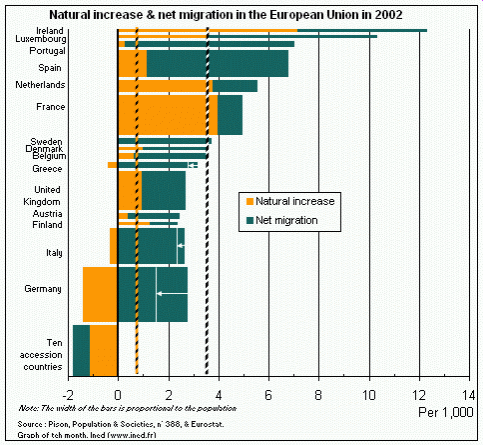Natural increase and net migration in EU-15, in 2002
Natural increase and net migration in the countries of the European Union in 2002

Reading the graph
This graph shows natural population increase and net migration in the EU-15 countries in 2002.
Each country is represented by a bar whose width is proportional to its population size. The length of the light coloured portion of each bar indicates the rate of natural increase (births minus deaths) and the length of the dark part the net migration rate (arrivals minus departures) per 1,000 inhabitants. The countries are ranked by their total growth rate (natural increase + net migration).
As the width of the bars is proportional to population size, their surface area represents the absolute value of natural increase (light-coloured surface area), of net migration (dark-coloured surface area) and of total growth.
Mean growth rates in EU-15 are indicated by vertical lines. The mean rate of natural increase is +0.8‰ and the total growth rate is +3.6‰. The net migration rate is the difference between the two, i.e. +2.7‰. Greece, Italy and Germany have negative natural increase, which must be deducted from net migration to obtain total growth (white arrows and lines).
In EU-15, natural growth is driven by France and migratory growth by Germany and Spain
This graph shows that the high rates observed in the "small" EU countries make only a small relative contribution to total growth. The high growth rates in Ireland and Luxembourg (whose bar would be invisible if it was truly proportional to population size) contribute little in absolute terms, while net migration in Germany, which has close to the average rate, is as large, in absolute terms, as that of Spain.
This graph also illustrates the demographic weight of the ten countries which joined the European Union in 2004. They have a total population of 75 million, slightly less than that of Germany, and have negative natural growth and net migration.
Sources
These data published by Eurostat feature in Population & Societies, 388. Natural increase and net migration are shown on two separate graphs, one for rates, and one for absolute growth (figures 2a and 2b).
